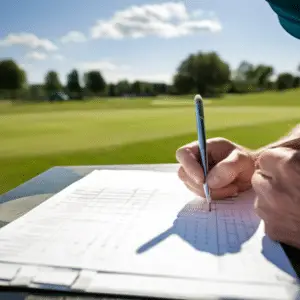Last Updated on June 12, 2023
Golf is a popular pastime for many, and it takes skill to master the game. Scorekeeping can be an important part of golfing, as keeping track of your score helps you to improve your game by analysing what works and what doesn’t. Knowing how to mark a scorecard accurately may seem intimidating at first, but with some practice, it’s easy! In this article, we’ll look at how to accurately mark a scorecard in golf according to its rules so that you know exactly where you stand on the course.
Types of Scores in Golf
Golf is a sport full of nuances, and scoring in golf can be complicated. There are three main types of scores: handicap score, Stableford points and scorecard tiebreakers.
Handicap score is the most common type of score used in tournament golf play. The purpose of this system is to level playing fields among players with different skill levels. In this system, each player’s course handicap – which takes into account their ability and experience – is subtracted from the total number of strokes it took them to complete the round. This provides an even comparison for all competitors regardless of how good or bad they may actually be at playing golf.
Stableford points are another popular form of scoring used on some courses. These points are awarded based on where your ball lands relative to certain ‘scoring zones’ on each hole; higher numbers indicate better shots taken during that particular hole. At the end of 18 holes, whoever has the highest cumulative point count wins the game or match-up.
Finally, if two players have identical scores at the end of a round (known as a ‘scorecard tiebreaker’), then additional criteria, such as who had fewer putts per hole, will determine who comes out ahead in terms of final standings.
Rules for Marking a Scorecard

First and foremost, it is important that players understand how to accurately record their scores. All strokes taken should be noted down, including any penalty strokes received due to rule infringements.
The player must also ensure that they sign and date the scorecard after each round, as this will guarantee its accuracy and validity. It is also worth noting that some clubs require all members to submit scorecards upon completion of play; these must include hole-by-hole totals and gross scores for every individual golfer. Furthermore, no alterations can be made once the card has been signed off by both parties involved in the game – failure to comply with this law could result in serious repercussions!
Penalties for Improperly Marking a Scorecard
If, after completing the play, any discrepancies or irregularities regarding the score recorded on the card become apparent, then penalties may be involved. For example, if an incorrect total has been entered as the final result due to inaccurate scoring or addition errors, then this will likely result in penalty strokes being taken against that particular player or team. Additionally, if a wrong figure has been marked on either front nine or back nine sections, this could incur a penalty fee. Therefore it is essential for players to take great care when filling out their cards so as to avoid incurring any extra costs through improper scoring or marking of the card.
How to Enter Strokes and Penalty Strokes on the Scorecard
To keep track of a round of golf, one must record the number of strokes taken on each hole on the scorecard. The total stroke count is entered in designated boxes next to each hole’s par value. Penalty shots are also noted and included as part of the total tally for that particular hole. When recording penalty strokes, it is important to initial them beside the corresponding entry so other players can easily identify why there was an increase in strokes from what was expected based on par.
In addition to noting any penalty strokes, the scorecard should also include notes about out-of-bounds balls or lost balls that have been hit during play. This helps ensure accuracy when calculating scores at the end of a match and allows players to quickly review their performance throughout a round more accurately than if these details were not recorded. It also allows others who review the scorecards later to better understand how certain scores were achieved and provides useful information for those analysing rounds played by different individuals.
Keeping Track of Putts on the Scorecard

Putts are a crucial part of golfing, as they determine how successfully a hole has been played. To properly record putts on the scorecard, one must be aware of some key points.
Firstly, each stroke taken from within 10 meters or 30 feet of the cup should be recorded as a ‘putt’. Secondly, any strokes that were taken outside this range will not count towards the total number of putts for that particular hole. Thirdly, if there was an approach shot which ended up within 1 meter (3 feet) of the cup but did not go in, this too can be counted as a putt and added to the total tally. Lastly, when entering your final score for each hole, you should include your total number of putts; this helps with accurately tracking progress over time by keeping track of scores and putting performance separately.
When recording data on the scorecard it’s essential to remember these rules regarding putt tracking so that accurate records can be maintained throughout a round of golf. This allows players to get an insight into their game – whether putting needs improvement or if other areas need more focus – all while maintaining accuracy with every entry made to their scorecard.
Writing Comments and Notes on the Scorecard
When marking notes on the scorecard, include everything that happened during the course of play – fairways hit, greens in regulation, putts taken and any penalty strokes incurred. It’s also useful to jot down anything noteworthy such as club selections or shots around the green, so they can be learned from and improved upon next time. Notes about golf should always be honest and accurate; this will help track progress over time and identify areas where improvement is needed.
Recording Out-Of-Bounds and Lost Ball Shots
When recording scores, golfers must factor in any out-of-bounds or lost ball shots they may have taken during the round. Out-of-Bounds (OB) shots and Lost Ball shots are scored differently from regular strokes. Here’s how to record them:
- Out of bounds – An OB shot occurs when a golfer hits their ball outside the course boundaries, such as into an adjacent field or over a fence. When this happens, the player must take a penalty stroke, which is recorded on their scorecard with a ‘+’ sign next to it. The golfer then plays the next shot from where the previous one was played, incurring another stroke and adding to their total for that hole.
- Lost Ball – This can occur if a golfer’s tee shot goes too far away and cannot be found after five minutes of searching. In this case, they must add two extra strokes onto their scorecard marked by two ‘+’ signs followed by the number three on the same line representing the combined three strokes incurred for failing to find their original ball within five minutes.
- Provisional balls – These are additional tee shots hit under certain circumstances when there is doubt about whether an initial shot has gone OB or has been lost due to a lack of visibility or other playing conditions, like heavy rain or foggy weather conditions. Players need only play provisional balls if there’s uncertainty about what happened to their first shot before taking any penalty strokes – otherwise, they should assume that it went OB or was lost and proceed accordingly as outlined in steps 1 & 2, respectively.
- Replay Shot – If your ball is unplayable anywhere on the course except in a water hazard, you can replay your last shot without penalty but at the cost of an extra stroke added to your par total per hole along with a ‘replay’ notation beside it written down on your card at the end of each hole completed.
Recording these types of penalties correctly ensures accuracy when tallying up final scores at the end of the game and avoids confusion later on when calculating which players are victorious overall!
Adding Up Total Scores After Completion of the Round
When rounding up a final total after the completion of a round, bear in mind that course rules may vary from place to place. Some courses require players always to round down their score while others demand they always round up, so check with staff prior to beginning play if unsure. To avoid disputes or mistakes when entering scores into official records, ensure that all numbers written down correspond exactly with those figures obtained through calculations made during play. This way, everyone can agree upon an accurate final scorecard total at the game’s end.
Conclusion
In conclusion, golf is a fun and exciting game that requires players to keep track of their own scores when playing with a group. The maximum number of strokes allowed for each hole is determined by the course you are playing on, so it’s important to know this before starting your round. When marking your scorecard, it’s best to use a pencil as there may be changes throughout the game. It’s also important to remember that playing out of turn can add penalty strokes to your total score. Finally, writing comments or notes on the scorecard can help you learn from mistakes and improve future performance – plus, it’s an enjoyable way of tracking progress over time! So next time you hit the links, ensure you know how to mark a scorecard properly!



